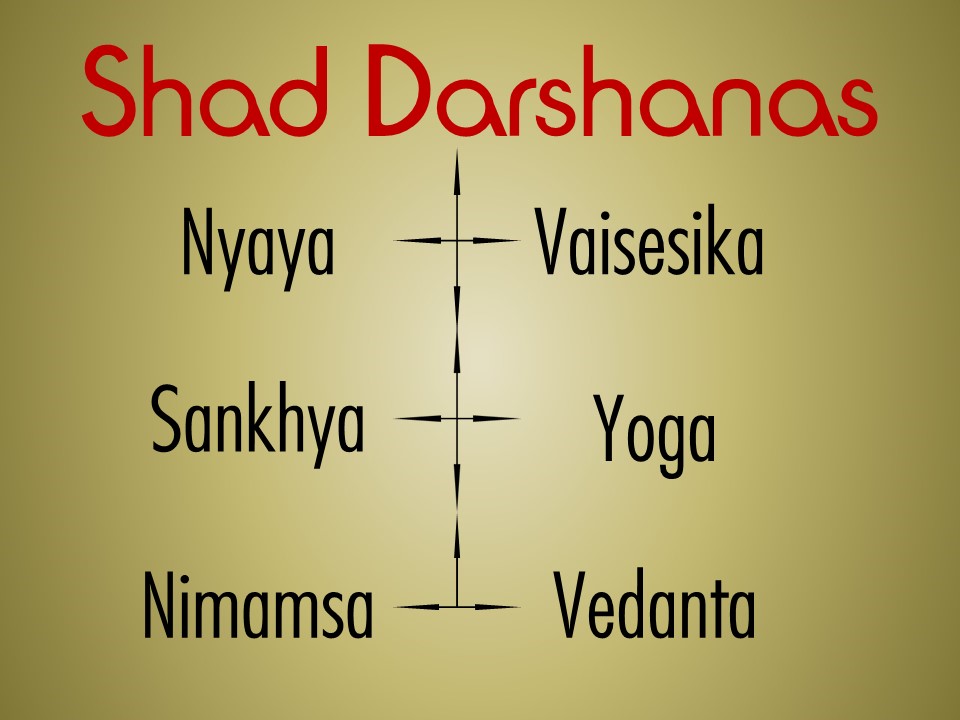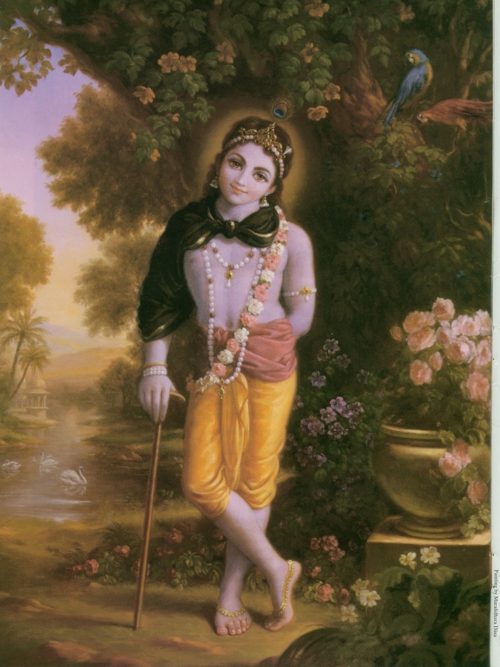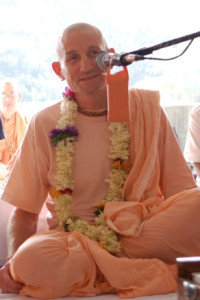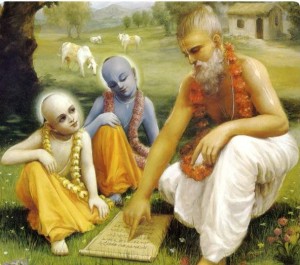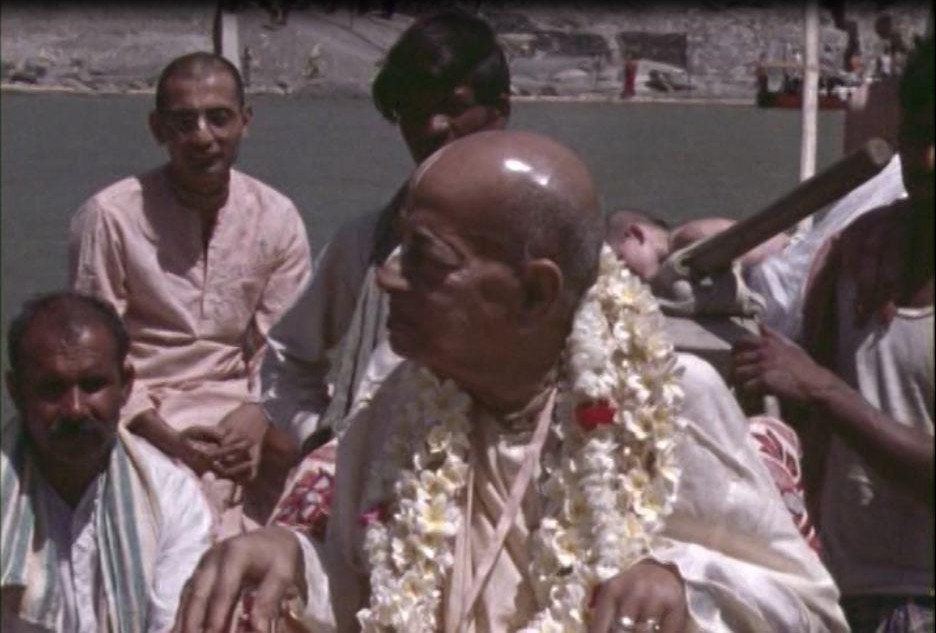
This is the second part of the blog on six branches of Vedic philosophy. In the last blog we read about these different philosophies or ṣaḍ-darśana, today we will read how they are connected with each other, each leading to another, like the rung of a ladder. Below is an excerpt from the book Ocean of Mercy by HH Bhakti Charu Swami. Maharaj is with Srila Prabhupada, the place is Rishikesh, somewhere between May 5 and May 15, 1977. Please relish the ease with which Srila Prabhupada unravels them.
A Question
Often, when senior devotees were gathered around Śrīla Prabhupāda in his room, he would spontaneously instruct them about devotional service.
On one such occasion, when I was sitting with the group, he said that an ideal preacher should have the proper understanding of the six branches of Vedic philosophy, ṣaḍ-darśana. “When one understands them properly,” he declared, “one can understand that devotional service is the ultimate goal of the Vedas. Only then does one become eligible to impart the conclusion of Vedic wisdom.”
I listened, a question flashed in my mind. Śrīla Prabhupāda had mentioned in his books that five out of six branches of Vedic philosophy were atheistic, so how could an understanding of those branches lead to the conclusion that devotional service to Krishna was the ultimate goal? I still felt shy to ask questions in front of the others, so I remained silent. But at night, when I was alone with Śrīla Prabhupāda, I remembered Tamāl Krishna’s advice. So I gathered my courage and asked, “Srila Prabhupada, in your books you mention that five of the six branches of ṣaḍ-darśana are considered atheistic. And at the beginning of Śrīmad-Bhāgavatam, Nārada Muni points out to Śrīla Vyāsadeva that even the sixth branch—Vedānta—is tinged with impersonalism. So that also falls short of perfection. Why, then, is it necessary to study them, and how is that knowledge going to benefit us? Is it in order to defeat the proponents of the other doctrines?”
Ultimate Goal
Śrīla Prabhupāda seemed pleased with my question. “No,”he explained, “our main business is not to defeat others, but to establish the fact that devotion to Krishna— Krishna consciousness—is the ultimate spiritual goal. This material nature is the perverted reflection of the spiritual reality. We have to understand that whatever is here in this world has its origin in the spiritual world. When in a reflection of a tree we see the green leaves, red flowers, and yellow fruits, we have to understand that they must be there in the real tree. Otherwise how can they be in the reflection? Everything is coming from the spiritual sky. Whatever is here in this material nature is also existing in the spiritual reality. “The perfect perception is to see things in that light. The Vedas have been designed to reveal the identity of Krishna and bring the living entities to His lotus feet. The six branches of Vedic philosophy are actually six steps of gradual elevation to understanding the ultimate goal—devotion to Krishna.
Six branches of Vedic Philosophy
“These six branches are Pūrva-mīmāṁsā [preliminary conclusions, or Karma-mīmāṁsā], Nyāya [logic], Vaiśeṣika [atomic theory], Sāṅkhya [analytical studies], Yoga [linking with the Supreme Lord], and Uttara-mīmāṁsā [final conclusions], Vedānta. If you simply regard them as independent branches of philosophy and study them without their relation to Krishna, they appear to be atheistic. These six branches are like rungs on a ladder. The rungs of the ladder by themselves cannot be the real goal. Their actual utility is in relation to the ladder, and the purpose of the ladder is to reach the ultimate height—devotional service to Krishna.
“The Vedas impart three levels of understanding—karma-kāṇḍa, jñāna-kāṇḍa, and bhakti.
Initially, one in this material nature wants to enjoy through sense gratification, and the karma-kāṇḍa section of the Vedas gives directions on how to enjoy. As you act, accordingly you will get the result: right action leads to enjoyment and wrong action to suffering. This is called the law of karma—the principle of action and reaction. Therefore, one must know how to act in order to really enjoy. Which can lead one to the highest region of the material universe—Satyaloka, where Lord Brahmā is situated. “However, in spite of all endeavors for enjoyment, one eventually realizes that he cannot avoid suffering—uninterrupted enjoyment is not possible in this material nature; suffering comes on its own and is unavoidable.
“When a person begins to wonder why he is suffering and tries to find the way out of it, he comes to the jñāna-kāṇḍa platform, and through four branches of Vedic philosophy—Nyāya, Vaiśeṣika, Sāṅkhya, and Yoga—he gradually transcends the material world and establishes his connection to the Lord in the heart.
Through Nyāya he comes to understand that this material nature is a place of suffering, duḥkhālayam, and that the material body is a perfect instrument for receiving pain. For example, just consider how many ways you can inflict pain on your little finger, or any part of your body, but you will find so few ways to give it pleasure—from which we can conclude that this material body is a wonderful instrument for receiving pain.
“Thereafter, one begins to consider what this material nature really is, and through the Vaiśeṣika branch of philosophy he realizes that the perceivable material world is actually composed of the minutest particles, called paramāṇu, or atoms. But to our senses it takes various shapes, forms, and perceptions. In other words, what appears to our senses to be real is not actually real. Therefore, this material nature is an illusion.
“This leads to the next branch of Vedic philosophy, called Sāṅkhya, or analytical study, which describes the material nature consisting of five elements—earth, water, fire, air, and ether, and the individual with five senses—eyes, ears, nose, tongue, and skin. The senses interact with the elements, and five objects of the senses are generated: the ears interact with ether, and sound is produced; the skin interacts with air, and touch is produced; the eyes interact with fire, and form is produced; the tongue interacts with water, and taste is produced; and the nose interacts with earth, and smell is produced. “There are also five working senses, with which we become active in this world—namely, the hands, legs, voice, anus, and genitals. In this way Sāṅkhya philosophy determines twenty tattvas, or aspects of material nature, and then considers three subtle elements beyond that—the mind, intelligence, and false ego—and subsequently, the mahat-tattva, the total material energy, from which the entire creation became manifest. “Through these twenty-four manifestations, Sāṅkhya philosophy analyzes the entire material nature. However, it concludes that these twenty-four manifestations are objective in nature and cannot exist without the subject—the ‘I’, the self, the soul. The entire material nature has been analyzed, but the soul cannot be found there; therefore, it comes from another reality—the spiritual nature—and has its origin, its source, in the Supreme Soul, or the Supreme Personality of Godhead. In this way, Sāṅkhya philosophy takes one to the spiritual reality and transcends the material nature.
“Recognition of the fact that the soul is a part of the Supreme Personality of Godhead leads to the final aspect of jñāna-kāṇḍa, called Yoga. Yoga is the process by which the spirit soul becomes connected to the Supersoul, or the Supreme Personality of Godhead. This process has eight different stages, or limbs; therefore, it is called aṣṭāṅga-yoga—yama, niyama, āsana, prāṇāyāma, pratyāhāra, dhyāna, dhāraṇā, and samādhi. In the final stage, samādhi, one perceives the Supersoul—the Supreme Personality of Godhead—in one’s heart. Recognizing one’s minuteness and the greatness of the Supreme Lord, one’s head automatically bends down in respect and one surrenders to Him.
Perfect Understanding
“This surrender to the Lord is the very foundation of devotional service—bhakti, the main aspect of the final branch of Vedic philosophy—and it has been explained through the sixth branch of Vedic philosophy, called Uttara-mīmāṁsā, or the final conclusion. It is also called Vedānta. The Vedanta philosophy is based on the Vedānta-sūtra, which apparently refers to the impersonal Brahman, but in his natural commentary on the Vedānta-sūtra, Śrīmad-Bhāgavatam, Śrīla Vyāsadeva establishes that surrender to the Supreme Personality of Godhead and loving devotional service to Him is the actual objective of Vedānta philosophy. Thus bhakti takes one beyond liberation to engagement in loving devotional service to the Lord. “In this way, through karma-kāṇḍa and jñāna-kāṇḍa, one is gradually elevated to the ultimate point of devotional service to the Supreme Personality of Godhead. This is the perfect understanding of the six branches of Vedic philosophy.”
I hope we learned something about six branches of Vedic philosophy, their conclusions, how each one leads to the next one, leading to their final destination- the lotus feet of Sri Krishna.
It is our good fortune that by the mercy of Srila Prabhupada many complex topics have been revealed to us in an easy to understand manner. It may be a good idea to read Srila Prabhupada’s books every day.
All glories to Srila Prabhupada.
Your servant,
Giriraj dasa

